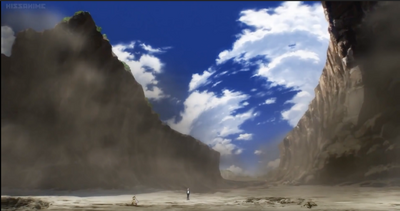The official discord link if you wish to join the discord: https://discord.gg/j5RKwCvAFu
Support the wiki on our official Ko-Fi page or Patreon page!
Attack Potency

Attack Potency
Destructive Capacity is the term used to determine the amount of damage a character can produce. It is measured in units of energy. An alternative term for Destructive Capacity which has more direct meaning: The Destructive Capacity that an attack is equivalent to. A character with a certain degree of attack potency does not necessarily need to cause destructive feats on that level, but can cause damage to characters that can withstand such forces.
Area of Effect Misconceptions
A regular argument used against a character falls under that they should not be a tier because they have never been shown destroying an object that matches the level of the name (I.E. Link cannot be planet because he never destroys a planet, nor do any of his sword slashes destroy a planet). Using this argument is extremely flawed as it not only ignores the existence of area of effect, but would also with using this logic make a human stronger then a bullet. To explain this, take a hypothetical example of someone punching through an interior wall vs. bullet being shot at an interior wall. If a bullet is shot at a wall, the wall would have a small hole from the bullet going through it, however if a person punches through a wall, a big hole would be left in place due to the size of the hand, with the logic of ignoring one's energy output in place for area of effect, the person's punch would in that scenario be stronger then a bullet.


Attack Potency Chart
| Tier | Level | Energy in
Conventional Terms |
Energy in Tonnes
of TNT Equivalent |
Energy in Joules | High End to Low End ratio |
|---|---|---|---|---|---|
| 10-C | Below Average | ~0 Joules to 1.195×10−8
50 Joules |
~0 to 9.56x10−9 | ~0 to 5x101 | N/A |
| 10-B | Human | 50 Joules to
130 Joules |
1.195×10−8 to 3.1071×10−8 | 5x101 to 1.3x102 | 2.6x |
| 10-A | Athlete | 130 Joules to
300 Joules |
3.1071×10−8 to 7.17x10−8 | 1.3x102 to 3x102 | ~2.307x |
| 9-C | Peak Human | 300 Joules to
14 Kilojoules |
7.17x10−8 to 3.34608×10−6 | 3x102 to 1.4x104 | 46.67x |
| 9-B | Wall | 14 Kilojoules
to 0.00023 Tons |
3.59x10−6 to 2.39006×10−4 | 1.4x104 to 1×106 | ~71.43x |
| 9-A | Room | 0.00023 Tons
to 0.055 Tons |
2.39006×10−4 to 5.5x10−2 | 1×106 to 2.3012×108 | 230.12x |
| Low 8-C | Small Building level | 0.055 Tons
to 0.25 Tons |
5.5x10−2 to 2.5x10−1 | 2.3012×108 to 1.046x109 | 4.54x |
| 8-C | Building | 0.25 Tons
to 1 Tons |
2.5x10−1 to 1 | to 1.046x109 to 4.184×109 | 4x |
| High 8-C | Large Building | 1 Tons to
10 Tons |
1 to 1x101 | 4.184×109 to 4.184×1010 | 10x |
| 8-B | City Block | 10 Tons to 100 Tons | 1x101 to 102 | 4.184×1010 to 4.184x1011 | 10x |
| 8-A | Multi-City Block | 100 Tons to 10 Kilotons | 102 to 1x104 | 4.184x1011 to 4.184×1013 | 100x |
| 7-C | Town | 10 Kilotons to
1 Megaton |
1x104to 106 | 4.184×1013 to 4.184x1015 | 100x |
| 7-B | City | 1 Megaton to 100 Megatons | 106 to 1x108 | 4.184x1015 to 4.184x1017 | 100x |
| 7-A | Mountain | 100 Megatons
to 1 Gigaton |
1x108 to 1x109 | 4.184x1017 to 4.184x1018 | 10x |
| 6-C | Island | 1 Gigatons
to 1 Teraton |
1x109 to 1x1012 | 4.184x1018 to 4.184x1021 | 1000x |
| Low 6-B | Small Country | 1 Teraton to 10 Teratons | 1x1012 to 1x1013 | 4.184x1021 to 4.184x1022 | 10x |
| 6-B | Country | 10 Teratons
to 500 Teratons |
1x1013 to 5x1014 | 4.184x1022 to 2.092x1024 | 50x |
| High 6-B | Large Country | 500 Teratons
to 1 Petaton |
5x1014 to 1x1015 | 2.092x1024 to 4.184x1024 | 2x |
| 6-A | Continent | 1 Petaton
to 40 Petatons |
1x1015 to 4x1016 | 4.184x1024 to 1.674x1026 | ~40x |
| High 6-A | Multi-Continent | 40 Petatons to
28.6 Exatons |
4x1016 to 2.87x1019 | 1.674x1026 to 1.2x1029 | ~716.85x |
| 5-C | Moon | 29.6 Exatons to
430 Exatons |
2.87x1019 to 4.3x1020 | 1.2x1029 to 1.8x1030 | ~14.53x |
| Low 5-B | Small Planet | 433 Exatons
to 48 Zettatons |
4.3x1020 to 4.8x1022 | 1.8x1030 to 2x1032 | ~111.11x |
| 5-B | Planet | 48 Zettatons
to 493 Yottatons |
4.8x1022 to 4.93x1026 | 2x1032 to 2.063x1036 | 10,315x |
| 5-A | Large Planet | 493 Yottatons
to 7.505 Tenatons |
4.93x1026 to 7.505x1030 | 2.063x1036 to 3.139x1040 | ~15,215.71x |
| Low 4-C | Small Star | 7.505 Tenatons
to 55 Tenatons |
7.505x1030 to 5.49x1031 | 3.139x1040 to 2.3x1041 | ~7.33x |
| 4-C | Star | 55 Tenatons
to 912.295 Tenatons |
5.49x1031 to 9.12x1032 | 2.3x1041 to 3.817x1042 | ~16.59x |
| High 4-C | Massive Star | 912.295 Tenatons
to 1 Foe |
9.12x1032 to 2.39x1034 | 3.817x1042 to 1x1044 | ~26.20 |
| 4-B | Solar System | 1 Foe
to 121.98 GigaFoe |
2.39x1034 to 2.92x1045 | 1x1044 to 1.22x1055 | 122,000,000,000x |
| 4-A | Multi-Solar System | 121.98 GigaFoe
to 1.61 YottaFoe |
2.92x1045 to 3.857x1058 | 1.22x1055 to 1.614x1068 | ~13,229,508,196,721.31x |
| 3-C | Galaxy | 1.61 YottaFoe
to 1.61 NinaFoe |
3.857x1058 to 3.857x1061 | 1.614x1068 to 1.614x1071 | 1000x |
| 3-B | Multi-Galaxy | 1.61 NinaFoe
to 19.63 TenaexaFoe |
3.857x1061 to 4.693x1083 | 1.614x1071 to 1.963x1093 | ~1.22x1022x |
| 3-A | Universal | 19.63 TenaexaFoe to any higher finite number | 4.693x1083 to any higher finite number | 1.963x1093 to any higher finite number | Not available |
Explanations
This blog explains the reasons for our borders and how we've found our numbers.
Standard sizes
- Moon level: Earth's satellite Moon.
- Small Planet level: Mercury.
- Planet level: The Earth.
- Large Planet level: Jupiter.
- Small Star level: OTS 44.
- Star level: The Sun.
- Large Star level: Rigel
- Solar System level: The star system known as the Solar System.
- Multi-Solar System level: Instead of doubling the value of Solar System level, the distance between two such systems needs to be accounted for as well. The calculation for energy required to destroy two solar systems was done, with the following assumptions:
- Distance from Proxima Centauri b, an object in another solar system with the lowest distance, 4.2 light-years or 4.0×10^13 km.
- A spherical blast, strong enough to obliterate the contents of both solar systems at the same time.
- Galaxy level: The Milky Way galaxy.
- Multi-Galaxy level: Instead of doubling the value of Galaxy level, the distance between two galaxies needs to be accounted for as well. The calculation for energy required to destroy two galaxies was done with the assumptions:
- Distance between two galaxies, which is listed as one million lightyears.
- A spherical blast, strong enough to obliterate the contents of both galaxies at the same time.
- Universe level: Given that the universe's actual size is unknown, we do not know the amount of energy that would be required to destroy all matter within it. As such, the bare minimum value using inflation theory is used as the lower border for this tier. Any greater finite number is also included within this tier, whereas countably infinite numbers are included under Universe level+.
Omitted levels
- Multi-City Block level: Towns do not have a consistent enough size to meet this standard, with the smallest town reaching around Multi-City Block level results to destroy.
- Town level+: Large Towns are normally rare or are essentially cities.
- Small City level: Cities do not have a consistent enough size to meet this standard.
- Large Mountain level: Mountains do not have a consistent enough size to meet this standard.
- Large Island level: Islands do not have a consistent enough size to meet this standard.
- Small Continent Level: It intersects with Large Country Level.
- Small Moon level: While most other tiers have been into 3 sub-tiers, Moon level does not have Small Moon level due to the existence of Multi-Continent level. Simply put, the two intersect, and Multi-Continent level is far more common than Small Moon.
- Multi Planet Level: Large Planet Level is far more common than Multi Planet level.
- Large Star level: A star does not get a higher GBE via its size but it’s solar mass. So a star that’s visually smaller could actually have a greater GBE then a star that’s visually larger. Thus Massive Star level is the more accurate term.
- Small Galaxy level: Same reason as the one for Small Moon level, with the tier clashing with Multi-Solar System level instead.
- Large Galaxy level: Large Galaxy level was omitted because unlike planets, galaxies in fiction rarely specify the size of said galaxy, and instead go from galaxy to multiple galaxies. As such, a "Large Galaxy level" rating would not only be confusing, but also redundant.
- Small Universe level: Intersects with Multi-Galaxy level, using the observable universe is far too specific as very few characters in fiction destroy specifically the observable universe.
- Higher Hierarchal levels: These levels are not listed because they are not restricted to the same parameters for energy requirement. The energy for such levels cannot be calculated.
Additional terms
"+" symbol
The "+" symbol is used when the Attack Potency has been calculated to be greater than the average (arithmetic mean) of the high end energy level and low end energy level of a particular tier.
Example: Average of Large Building level is: [2 Tons (low end) + 11 tons (high end)]/2 = 6.5 Tons (the arithmetic mean). All energy levels from 2 Tons to 6.5 Tons should be listed as Large Building level, whereas all energy levels from 6.5 Tons to 11 Tons should be listed as Large Building level+.
At least
Should be used to denote the lower cap of a character, if the exact value is indeterminate. Usually listed for characters that have done a feat superbly casually.
At most
Should be used to denote the higher cap of a character, if the exact value is indeterminate. Usually listed for characters that have done a feat that is questionable compared to their other feats.
Likely
Should be used to list a hypothetical statistic for a character, but inconclusive due to lack of feats or viable power-scaling. Probability of said hypothetical statistic should be favourable.
Possibly
Should be used to list a hypothetical statistic for a character, but inconclusive due to lack of feats or viable power-scaling. Probability of said hypothetical statistic should also be indeterminate.
Discussions (Link For Mobile Users):
| Discussion threads involving Attack Potency |
